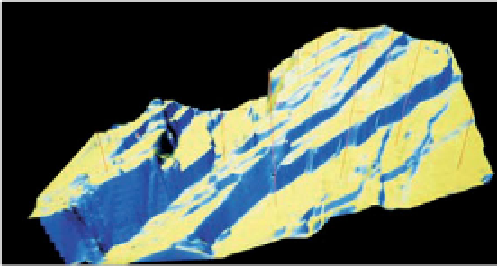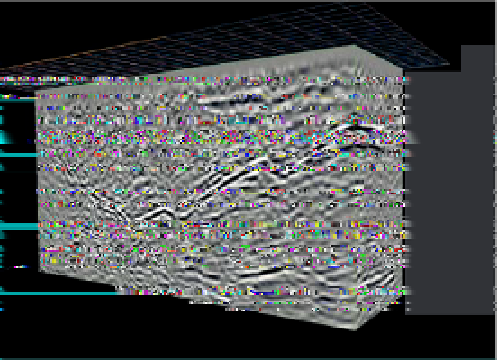Geoscience Reference
In-Depth Information
a)
a)
Source
Detector
Fresnel volume
Z
V
1
V
2
V
2
VCR
V
1
D
Fresnel
Depth
(
Z
)
b)
200 m
Source/detector location
Surface
Oblique
path
Normal
incidence
path
Constituent point diffractor
b)
F r e s n e l z o n e
Depth
(
Z
)
R e fl e c t o r
D
Fresnel
Figure 6.42
Schematic illustration of the re
ection Fresnel volume.
(a) Cross-section, and (b) the Fresnel zone on the re
ector surface.
VCR
The re
ector is represented as a series of juxtaposed point diffractors.
0
~250
METRES
Metres
properties of a re
ector which occur over an area smaller
than the Fresnel zone are
, although in fact the
contribution from the central part of the zone is greater
than that from marginal areas.
Fortunately lateral resolution is signi
cantly improved by
migration which, in addition to repositioning re
ections,
reduces the Fresnel zone diameter. Ideally, this is to one-
quarter of the dominant wavelength (
'
averaged
'
c)
Drillhole
λ
Dom
/4), although half
a wavelength is a more realistic estimate of what is achieved
in practice.
Figure 6.43
shows how large this is for param-
eters typical of mining-oriented seismic data.
0
~250
Metres
Figure 6.41
Three-dimensional seismic datasets from the
Klerksdorp Goldfield. (a) 3D data volume, (b) a vertical section
and the horizon map of the Ventersdorp Contact Reef (VCR), and
(c) the VCR horizon map. (a) and (c), Redrawn, with permission,
Pretorius et al.(
2003
).
6.7.1.2
Vertical resolution
Vertical resolution is defined in terms of the minimum
vertical separation required between two reflectors for
them to create two separate arrivals on the seismic trace
(cf.
Fig. 6.5
). For the case of normal
incidence,
this
source then up after reflection, so the overall path differ-
ence is
requires the two re
ectors to be separated by a vertical
distance that is travelled in a time interval equal to a
quarter of the signal
/2. Calculating Fresnel-zone diameters and areas
for various combinations of frequency, velocity and depth
relevant to mineral exploration shows that diameters are
typically a few hundred metres and their areas around 5 to
10 ha. These can be thought of as the minimum area of a
discontinuity if it is to produce a reflection in unmigrated
data; otherwise it acts as a diffractor. Variations in the
λ
is dominant period. This distance is
travelled twice during a re
ected path and so the overall
difference in travel time is half the dominant period. In
distance terms, the re
ector separation is a quarter of the
dominant wavelength (
'
λ
Dom
/4), i.e. the same as the ideal
post-migration horizontal resolution.
Figure 6.43
shows












































































































































































































































































































































































































































Search WWH ::

Custom Search